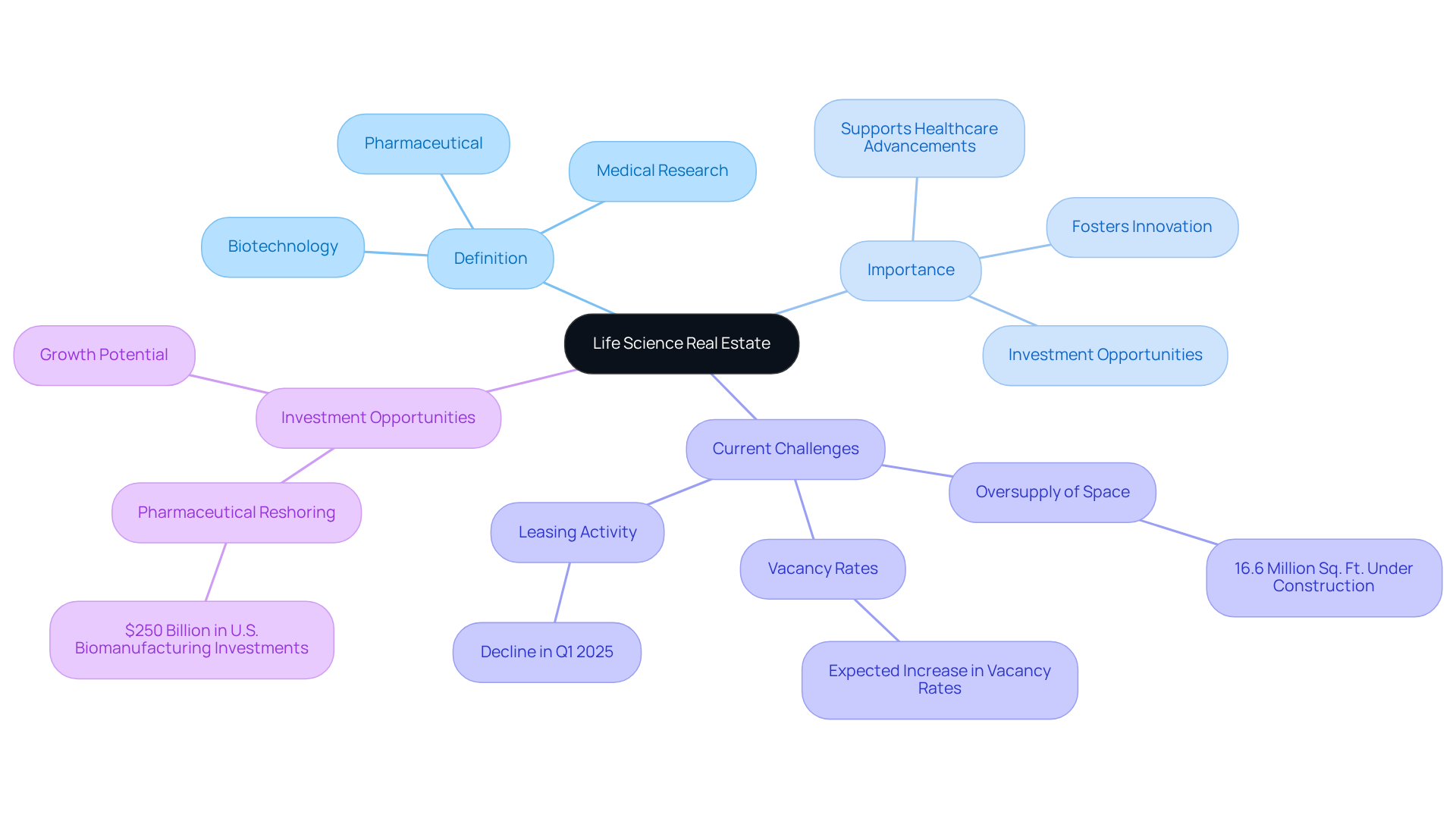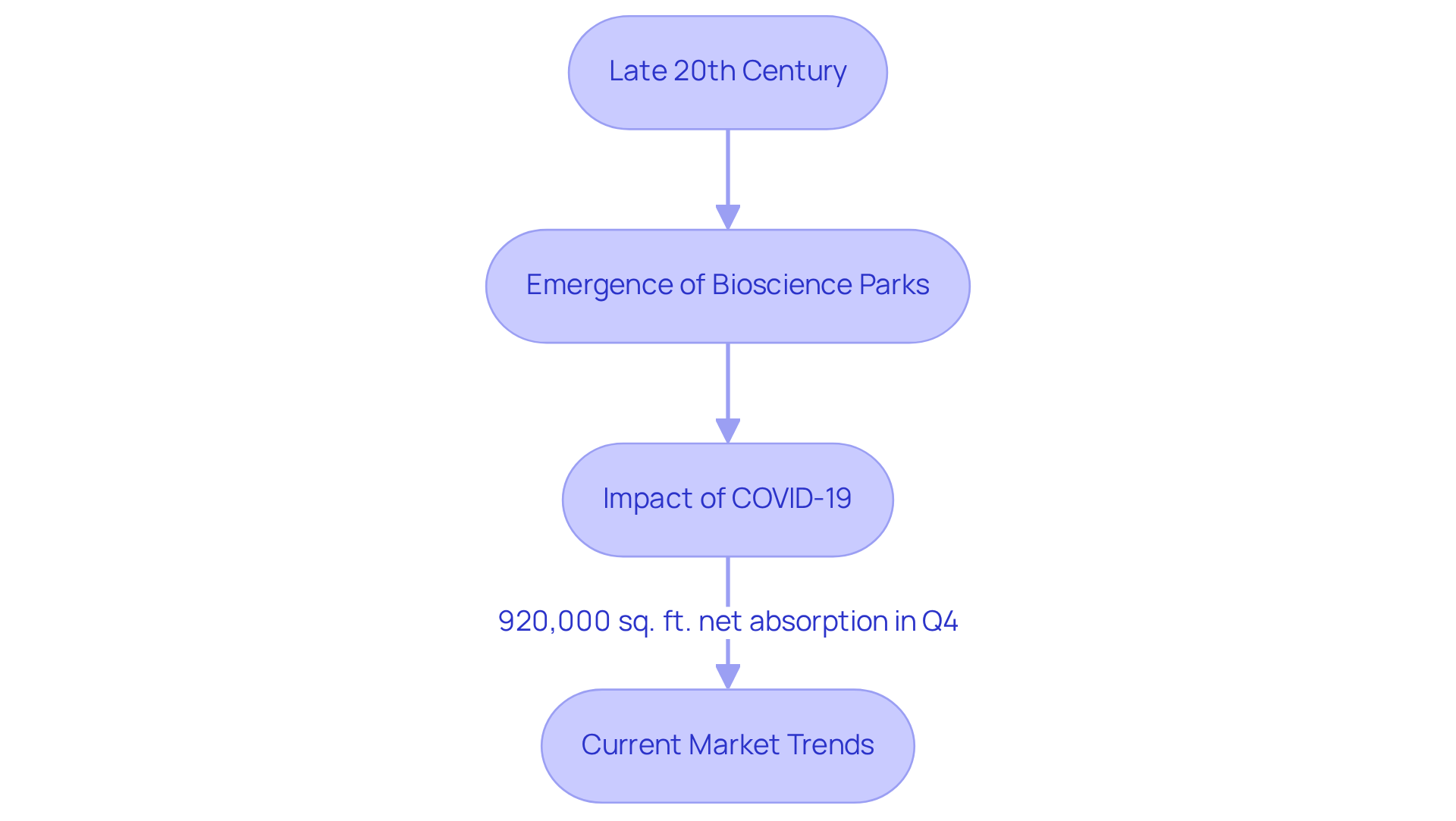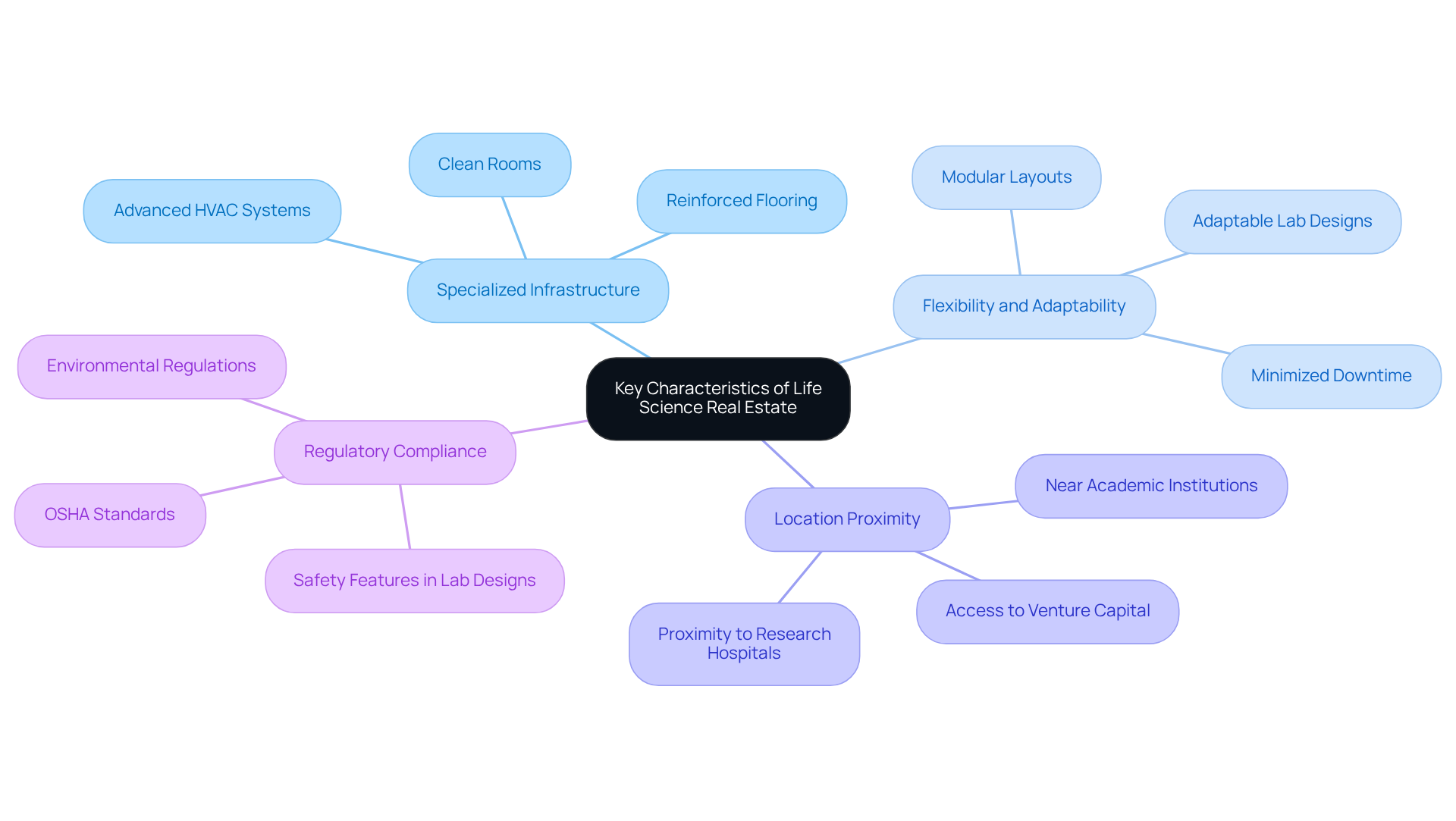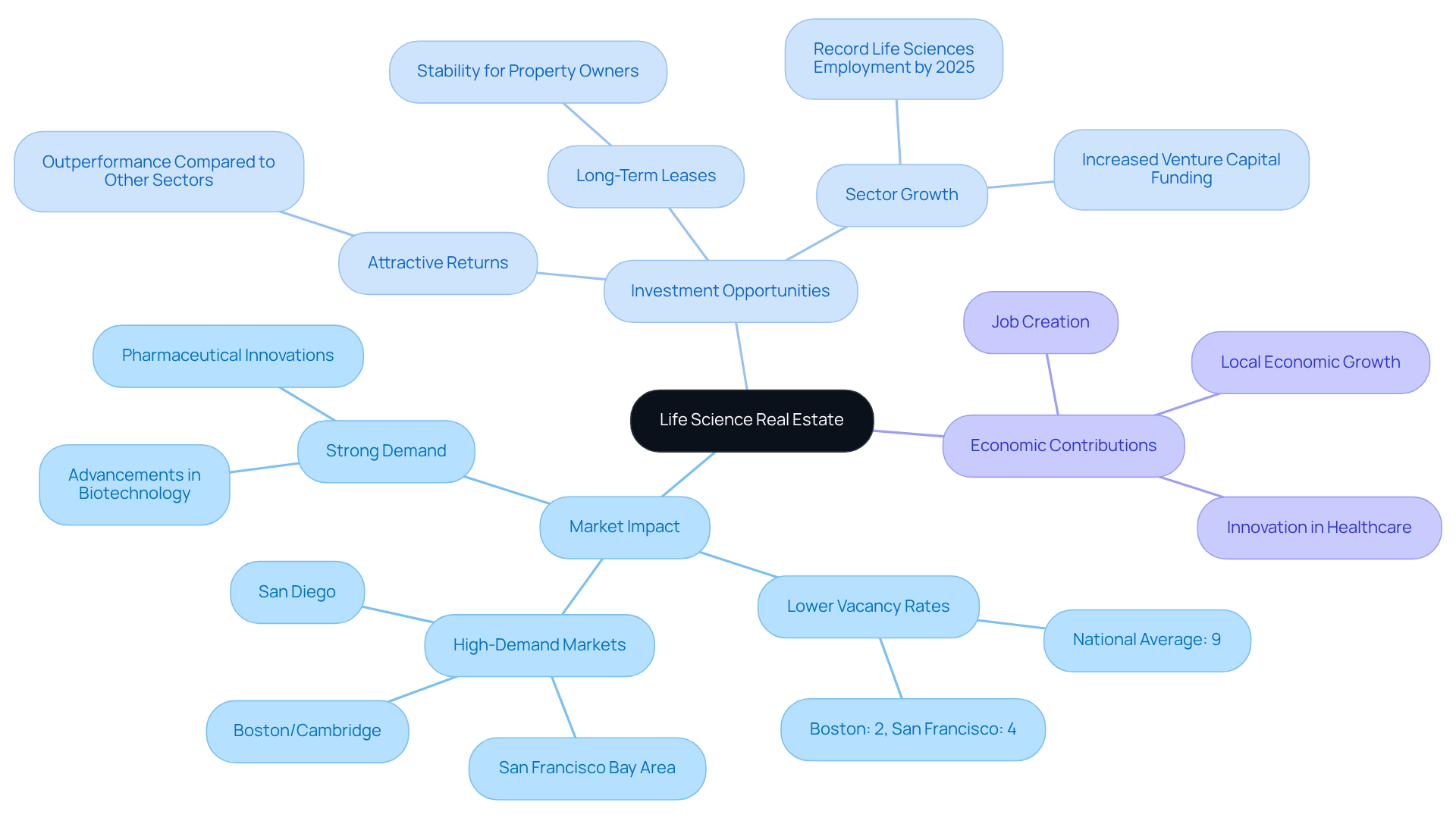Overview
Life science real estate encompasses properties meticulously designed for biotechnology, pharmaceutical, and medical research firms. These properties feature specialized infrastructure and strategic locations that foster innovation. This sector stands out as an attractive investment opportunity due to strong demand, lower vacancy rates compared to traditional commercial properties, and significant growth potential fueled by advancements in healthcare and biotechnology.
Investors should take note of the compelling dynamics at play. The increasing need for specialized facilities has led to a surge in demand, making life science real estate a resilient sector. Furthermore, the lower vacancy rates indicate a robust market, providing a sense of security for potential investors. As advancements in healthcare and biotechnology continue to evolve, the prospects for substantial growth in this sector become increasingly evident.
In conclusion, life science real estate represents a unique investment avenue worth considering. By understanding the underlying trends and market demands, investors can position themselves advantageously within this thriving sector. The combination of strong demand and growth potential makes life science real estate a compelling choice for those looking to diversify their portfolios.
Introduction
The realm of life science real estate is rapidly evolving, propelled by the increasing demand for innovative healthcare solutions and the burgeoning biotechnology sector. This specialized asset class not only addresses the infrastructure needs of pharmaceutical and medical research firms but also offers significant investment opportunities for astute property professionals.
In a landscape characterized by both growth and the potential for oversupply, how can investors effectively navigate the complexities of this unique market to capitalize on its promising future? This question underscores the necessity for informed strategies in an ever-changing environment.
Define Life Science Real Estate: Scope and Importance
What is life science real estate refers to properties specifically designed to cater to the needs of firms in the biotechnology, pharmaceutical, and medical research industries. This asset class, which includes laboratory spaces, research facilities, and office environments, helps to illustrate what is life science real estate that fosters scientific innovation and healthcare advancements. In recent years, understanding what is life science real estate has become increasingly significant, driven by heightened demand for healthcare solutions and technological advancements in the biological sector. However, the market faces challenges, including a projected oversupply of lab and R&D space, with 16.6 million square feet currently under construction and an anticipated rise in overall vacancy rates across major health sectors.
Consequently, this category of property is not only a crucial component of the healthcare framework but also illustrates what is life science real estate, presenting lucrative investment opportunities for property professionals and investors. The ongoing trend of pharmaceutical reshoring, highlighted by over $250 billion in U.S. biomanufacturing investments announced, underscores the sector's resilience amid market challenges. Nevertheless, it is important to note that lab leasing activity saw a significant decline in Q1 2025, indicating potential volatility in the market. As we move further into 2025, the biological property landscape is expected to continue evolving, fueled by innovation and an aging demographic that increases the demand for laboratory space.
Investors are increasingly interested in what is life science real estate due to the substantial potential for growth in this asset class, making it an attractive focus for capitalizing on the future of healthcare.

Trace the Evolution of Life Science Real Estate: Historical Context
The development of biological real estate traces its roots to the late 20th century, a period marked by significant advancements in biotechnology and pharmaceuticals. Initially, laboratory spaces were predominantly situated within academic institutions and research hospitals. However, as the demand for specialized facilities surged, dedicated bioscience parks and clusters began to emerge, particularly in regions with strong academic and research foundations, such as Boston and San Francisco. The COVID-19 pandemic accelerated this trend, underscoring the vital role of biological studies in public health and prompting substantial investments in this sector.
For instance, the U.S. biological property market recorded a favorable net absorption of 920,000 sq. ft. in Q4, signaling robust demand. Today, biological property is recognized as a distinct asset category, attracting both institutional and private investors seeking stable returns and growth opportunities. As Lauren Gilchrist notes, biological firms thrive in dynamic ecosystems that encompass academic institutions and groups of scientific expertise, further emphasizing the importance of urban settings for innovation.

Identify Key Characteristics of Life Science Real Estate: Unique Features and Requirements
What is life science real estate is defined by several distinct features and requirements that are tailored to meet the specialized needs of its tenants.
- Specialized Infrastructure: Facilities in this sector demand advanced HVAC systems, reinforced flooring to support heavy equipment, and clean rooms to ensure controlled environments essential for research and development.
- Flexibility and Adaptability: The rapid pace of innovation necessitates properties designed for reconfiguration, often featuring modular layouts that can easily adapt to evolving research needs. For instance, contemporary biological facilities are increasingly shifting towards adaptable lab layouts, enabling effective space use and minimized downtime between projects. A prime example of this trend is Eikon Therapeutics' recent expansion into a 25,000 square foot headquarters.
- Location Proximity: Successful developments are strategically situated near academic institutions, research hospitals, and venture capital sources, fostering collaboration and innovation. The DC-Baltimore metro area, ranked No. 2 in the nation for biological research talent centers and No. 5 for employment in biological fields, exemplifies this trend, providing a robust ecosystem for biological studies.
- Regulatory Compliance: Adherence to stringent safety and environmental regulations is paramount, necessitating specialized design considerations and ongoing maintenance. Facilities must comply with Occupational Safety and Health Administration standards, ensuring safety features are integrated into lab designs.
Moreover, the vacancy rate for biological properties increased to 5.7% in Q4 2022 from 5.1% in Q3 2022, indicating the growing demand for high-quality research environments. These traits not only enhance the operational efficiency of biological facilities but also significantly increase their attractiveness as investment prospects, particularly in understanding what is life science real estate, as the sector continues to expand amidst rising demand for high-quality research environments. In 2023, $583 billion was invested in biotechnology firms, underscoring the financial support and growth potential of this sector.

Examine the Significance of Life Science Real Estate: Market Impact and Investment Opportunities
The significance of biological property extends beyond its direct function as a site for research and development. It is pivotal in fostering economic growth, job creation, and innovation within the healthcare sector. As the demand for healthcare solutions escalates, biotechnology properties are increasingly viewed as a formidable investment category, offering lower vacancy rates and stable returns compared to traditional commercial properties. Currently, the national average vacancy rate for commercial properties in the biological field stands at 9%, which is significantly lower than many conventional sectors. In high-demand markets such as Boston and San Francisco, vacancy rates plummet to as low as 2% and 4%, respectively.
Investors are attracted to life science real estate for several compelling reasons:
- Strong Demand: The continuous advancements in biotechnology and pharmaceuticals generate a steady requirement for specialized facilities, ensuring robust occupancy rates.
- Long-Term Leases: Life biology tenants frequently enter into longer lease agreements, providing stability and predictability for property owners.
- Attractive Returns: Historically, this sector has outperformed other property asset classes, making it an enticing option for investors seeking diversification and growth.
The economic impact of biological property is substantial, contributing significantly to local economies, particularly in high-demand markets. As the biological sector continues to evolve, the real estate industry is well-positioned to capitalize on increased investment and development opportunities, prompting the inquiry of what is life science real estate and solidifying its role as a key player in the commercial real estate landscape. With projections indicating stronger economic growth and record life sciences employment by 2025, the sector is poised to draw even greater interest from astute investors eager to leverage its unique advantages.

Conclusion
Life science real estate represents a unique and essential asset class specifically designed to meet the specialized needs of the biotechnology, pharmaceutical, and medical research industries. As demand for healthcare solutions continues to rise, the significance of these properties becomes increasingly apparent. The interplay between innovation, regulatory compliance, and strategic location underscores the vital role that life science real estate plays in advancing scientific research and healthcare advancements.
Key insights from the article highlight the sector's evolution, characterized by a shift from traditional laboratory spaces to dedicated bioscience parks and facilities. The importance of specialized infrastructure, flexibility in design, and proximity to academic institutions are crucial factors that enhance the operational efficiency of these properties. Furthermore, the market shows promising investment opportunities, driven by strong demand, long-term leases, and attractive returns compared to conventional real estate sectors.
In light of the ongoing advancements in biotechnology and the increasing need for research facilities, life science real estate stands at the forefront of economic growth and innovation. Investors and stakeholders are encouraged to recognize the potential of this sector, which not only contributes to local economies but also plays a pivotal role in shaping the future of healthcare. Engaging with life science real estate now could yield significant benefits, aligning investment strategies with the evolving landscape of health and science.




